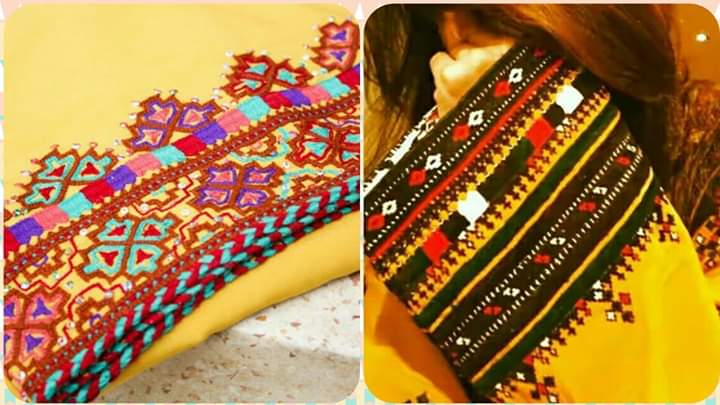Balochi embroidery is one of the oldest in the history. Balochi female dresses are very famous because of their unique embroidery patterns adopted from the very native land.
One of the most popular arts and crafts of the world is the Balochi embroidery, which is generally done by women. While most of the motifs and designs of Balochi embroidery have been inspired by nature, some of the patterns take brainwave from the pottery of the Mehrgarh civilization, one of the oldest civilizations. The art, which involves the use of threads, beads and tiny mirrors, has been passed down for many generations. “This is an integral part of the Baloch culture, which has been inherited by our ancestors,”
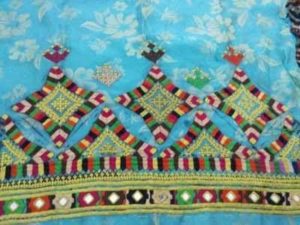 The embroidery is considered by many as a Baloch emblem, distinguishing the culture of Balochistan with that of other ethnic groups. “The colorful and distinct embroidery patterns serve as ethnic markers, which differentiate Balochs from others. However, even within Balochistan, there are different embroidery designs and terminologies applied to garments from different tribes of the region. . Name of Some of the popular embroideries are worth mentioning such as “Kapuk, Panch, Thaitookh, Jallar, Mehrab, Kantolo, Chandanohar, Cha’war, Mirchok o chamok, Morg-o-paanch, Gad-o-band, Jadok, Chamkali, Arif-e-chadar and Dillobita, Jadok, Bibi-e-tik, Kapoot-e-Telag, Shuchul, Double Suchul, Bakal-e-sarok, Shams tak, Chhum-e-Mataj, Voley-o-Bali, Dushman doch, Gobi-e-Phul, Nakali Kargo, Mehrgi, Sipat-o-stah, Kushash, Baghdadi hapt kap, Sol-e-tak, Cheelako, Watt, Murg, Keek-e-Naal, Turbat-e-Banor, Allahnazari Top, Zurto, Zulfi, Mehrab-e-Kalat, Murg-o-churo, Kashish, Chilam, Sabzo, Cham-e-Surmag Kantuk, Kantuk-e-Naal, Zupi, Bipi Loli, Zum-e-Tej, Taeduk,Cheek, Siah-o-Suped, Kalati Pur, Arbi Pur, Tanab, Kaput-e-talo, Tamatrok, Caoch-e-bus,Kech-e-Channel, Nakali talo, Banor-e-Shams, Chaeal or Abida passand, Sheren Janek or Koh-e-Sare Banok, Phuldoch, Sadam-e-Taj, Pudiwar, Roch-e-Brenz, Gezhuk, Kanch-o-Kabat, Payaladoch, Charghani, Longen, Biscuitidoch, Hazarsheesha, Kashmiridanke, Argh-e-Langer, Petenko, Dilkurak, Dosoti, Zeba Bakhtiar, Showcasi, Bilinagidan, Kundi, Cham-e-Barunk, Mukari, Kachdanka, Mosami, Bost, Haptranga, Jamalkun, Gulkasheeda, Khabri, Haddi, Dungdi, Sarae, Kachhidoch, Panjbahar, Darchkok, Mand-o-Bulo, Jug-o-Gilas, Jenkok, Bagun-e-Dast, Murgo, Chiken, Kochnayat, Zakhmidil, Mechanahar, Roadblock, Nishar-o-Wasu, Moledo, Zubeda Jalal, Kapot-o-Namok, Gadaband, Noorkhan-e-Hars, Kap-o-Sansar, Talohark and many others. “The areas where such kind of embroidery is made are Makran, Kalat, Mastung, Noshki, kohlu, Dera Bugti, Sibi, Jhal Magsi and Khuzdar. An average dress takes 3 to 9 months to get completed.
The embroidery is considered by many as a Baloch emblem, distinguishing the culture of Balochistan with that of other ethnic groups. “The colorful and distinct embroidery patterns serve as ethnic markers, which differentiate Balochs from others. However, even within Balochistan, there are different embroidery designs and terminologies applied to garments from different tribes of the region. . Name of Some of the popular embroideries are worth mentioning such as “Kapuk, Panch, Thaitookh, Jallar, Mehrab, Kantolo, Chandanohar, Cha’war, Mirchok o chamok, Morg-o-paanch, Gad-o-band, Jadok, Chamkali, Arif-e-chadar and Dillobita, Jadok, Bibi-e-tik, Kapoot-e-Telag, Shuchul, Double Suchul, Bakal-e-sarok, Shams tak, Chhum-e-Mataj, Voley-o-Bali, Dushman doch, Gobi-e-Phul, Nakali Kargo, Mehrgi, Sipat-o-stah, Kushash, Baghdadi hapt kap, Sol-e-tak, Cheelako, Watt, Murg, Keek-e-Naal, Turbat-e-Banor, Allahnazari Top, Zurto, Zulfi, Mehrab-e-Kalat, Murg-o-churo, Kashish, Chilam, Sabzo, Cham-e-Surmag Kantuk, Kantuk-e-Naal, Zupi, Bipi Loli, Zum-e-Tej, Taeduk,Cheek, Siah-o-Suped, Kalati Pur, Arbi Pur, Tanab, Kaput-e-talo, Tamatrok, Caoch-e-bus,Kech-e-Channel, Nakali talo, Banor-e-Shams, Chaeal or Abida passand, Sheren Janek or Koh-e-Sare Banok, Phuldoch, Sadam-e-Taj, Pudiwar, Roch-e-Brenz, Gezhuk, Kanch-o-Kabat, Payaladoch, Charghani, Longen, Biscuitidoch, Hazarsheesha, Kashmiridanke, Argh-e-Langer, Petenko, Dilkurak, Dosoti, Zeba Bakhtiar, Showcasi, Bilinagidan, Kundi, Cham-e-Barunk, Mukari, Kachdanka, Mosami, Bost, Haptranga, Jamalkun, Gulkasheeda, Khabri, Haddi, Dungdi, Sarae, Kachhidoch, Panjbahar, Darchkok, Mand-o-Bulo, Jug-o-Gilas, Jenkok, Bagun-e-Dast, Murgo, Chiken, Kochnayat, Zakhmidil, Mechanahar, Roadblock, Nishar-o-Wasu, Moledo, Zubeda Jalal, Kapot-o-Namok, Gadaband, Noorkhan-e-Hars, Kap-o-Sansar, Talohark and many others. “The areas where such kind of embroidery is made are Makran, Kalat, Mastung, Noshki, kohlu, Dera Bugti, Sibi, Jhal Magsi and Khuzdar. An average dress takes 3 to 9 months to get completed.
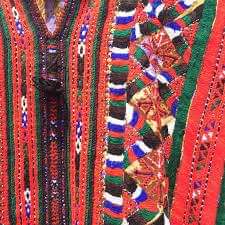 Meanwhile, selection of colors and designs of embroidered clothes differs from person to person rather than from area to area. One can easily judge the place of creation of the embroidery by its unmatchable patterns. The embroidered dress is weared by both young and older women. Whereas young girls prefer wearing embroideries in bright colors like pink, green, orange, yellow etc., the older women wear dark colors like blue, black or brown and according to the Baloch tradition it is compulsory for widows to wear black or dark colors.
Meanwhile, selection of colors and designs of embroidered clothes differs from person to person rather than from area to area. One can easily judge the place of creation of the embroidery by its unmatchable patterns. The embroidered dress is weared by both young and older women. Whereas young girls prefer wearing embroideries in bright colors like pink, green, orange, yellow etc., the older women wear dark colors like blue, black or brown and according to the Baloch tradition it is compulsory for widows to wear black or dark colors.
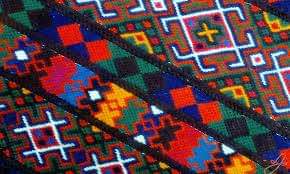 However, the art doesn’t just come naturally and women in Balochistan have to practice regularly to master the skill. These women usually set aside a few hours for embroidery after completing their daily household chores. “The girls and older women in interior Balochistan do not use charts or diagrams but create extremely complex designs in a random manner. They are guided by family members and elders of the area.” Meanwhile, tastes and preferences regarding the color of embroidered clothes differ for people belonging to different age groups. Whereas young girls prefer wearing embroideries in bright colors, older women wear dark colors like blue, black or brown and it is compulsory for widows to wear black or dark colors.
However, the art doesn’t just come naturally and women in Balochistan have to practice regularly to master the skill. These women usually set aside a few hours for embroidery after completing their daily household chores. “The girls and older women in interior Balochistan do not use charts or diagrams but create extremely complex designs in a random manner. They are guided by family members and elders of the area.” Meanwhile, tastes and preferences regarding the color of embroidered clothes differ for people belonging to different age groups. Whereas young girls prefer wearing embroideries in bright colors, older women wear dark colors like blue, black or brown and it is compulsory for widows to wear black or dark colors.
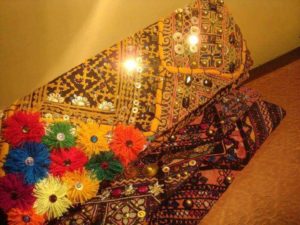 While both hand embroidery and machine embroidery have great commercial value, Baloch women in Karachi give preference to machine-embroidered and printed embroidery. The most expensive among these dresses, which range between Rs15,000 to Rs70,000, are made for brides. “It takes six months to a year to make one such dress,” However, women employed in the embroidery industry are exploited by retailers and dealers in cities, who pay them a very small percentage of the price of dresses.
While both hand embroidery and machine embroidery have great commercial value, Baloch women in Karachi give preference to machine-embroidered and printed embroidery. The most expensive among these dresses, which range between Rs15,000 to Rs70,000, are made for brides. “It takes six months to a year to make one such dress,” However, women employed in the embroidery industry are exploited by retailers and dealers in cities, who pay them a very small percentage of the price of dresses.

